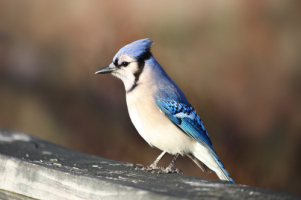
Blue Jays(Cyanocitta cristata) are probably one of the most well-known and most beautiful birds known to man. The Blue Jay is a very popular bird native to eastern North America and is known for its loud song and vibrant blue color.
While this bird is a true eye-pleaser, here we will go over everything you need to know about Blue Jays.
What Do They Look Like?
Blue Jays are generally bright blue in the upper body, and they also have black, blue, and white bands on their tails and wings.
When you look at the blue Jay from the front and stare at their chest, you will see that it is pure white, and the face and neck are also white. However, they have a black band or bridle around their face and neck.
Their bill is strong and usually black, and they have a slight blue crest on top of their head. Blue Jays use their blue crest for communication purposes.
Blue Jays are known as passerine birds, this means that they have three toes that point to the front and another toe that points to the back. This makes it easy for them to perch on branches.
Where Do They Reside?
Blue Jays are primarily found in the central and eastern parts of North America. However, they are spreading north west, and you can find them in southern Canada.
What Do They Eat?
The diet of a blue Jay consists of nuts, seeds, acorns, invertebrates, and small vertebrates. While they are primarily vegetarians, blue Jays have a bad rap for eating eggs of other birds. However, they love to eat acorns and will often store a bunch of them in the ground for later when they get hungry.
Mating
It’s unlikely that you will ever see a Blue Jay on its own. These birds are very social, and they will usually be seen with at least one or two other Blue Jays.
Once they find their mate, they will be with that mating partner for life. The mating season will last from March through July.
The male bird will bring its female some food while she is in the brooding process. Once the female lays eggs, you can expect anywhere between two to seven eggs. After about two weeks, the eggs will hatch, and new blue Jays will be welcomed to the world.
Blue Jays Song
As mentioned, the blue Jay communicates by singing and using its crest. If you ever see the crest stand erect, then that’s means that they are either annoyed or stressed out.
If the crest is flat, then that’s an indicator that they are at ease.
Blue Jays love to sing and call out to other birds. They can create different types of sounds, and some can imitate the calls of a hawk.
They will only imitate this sound if they want to scare off other animals.
Nesting
Unlike some birds, blue Jays are very adaptable and will live in almost any habitat. While they prefer woods and forests, they can live in urban areas or backyards of people’s homes.
Blue Jays are non-cavity nesters. Blue Jays build a cup-shaped nest on branches of a tree.
When a male and female are together, they will split up the work of building the nest. The males will often collect the materials needed to build the nest, and the females will build it.
The nest is comprised mostly of mud, roots, grass, and twigs.
Baby Blue Jays
Unlike blue Jay adults, who have a vivid blue color. Baby Blue Jays are born with not as vibrant colors as their parents, and they are born bald and blind.
After about twenty days, they will begin to venture out from the nest into the world but will stay with their parents for about another month or two.
The Predators
While these birds win in the beauty department, they are relatively slow flyers. This makes them a prime target for hawks, owls, and other large birds of prey.
Other animals such as squirrels, snakes, dogs, and cats will target baby Blue Jays and eggs.
